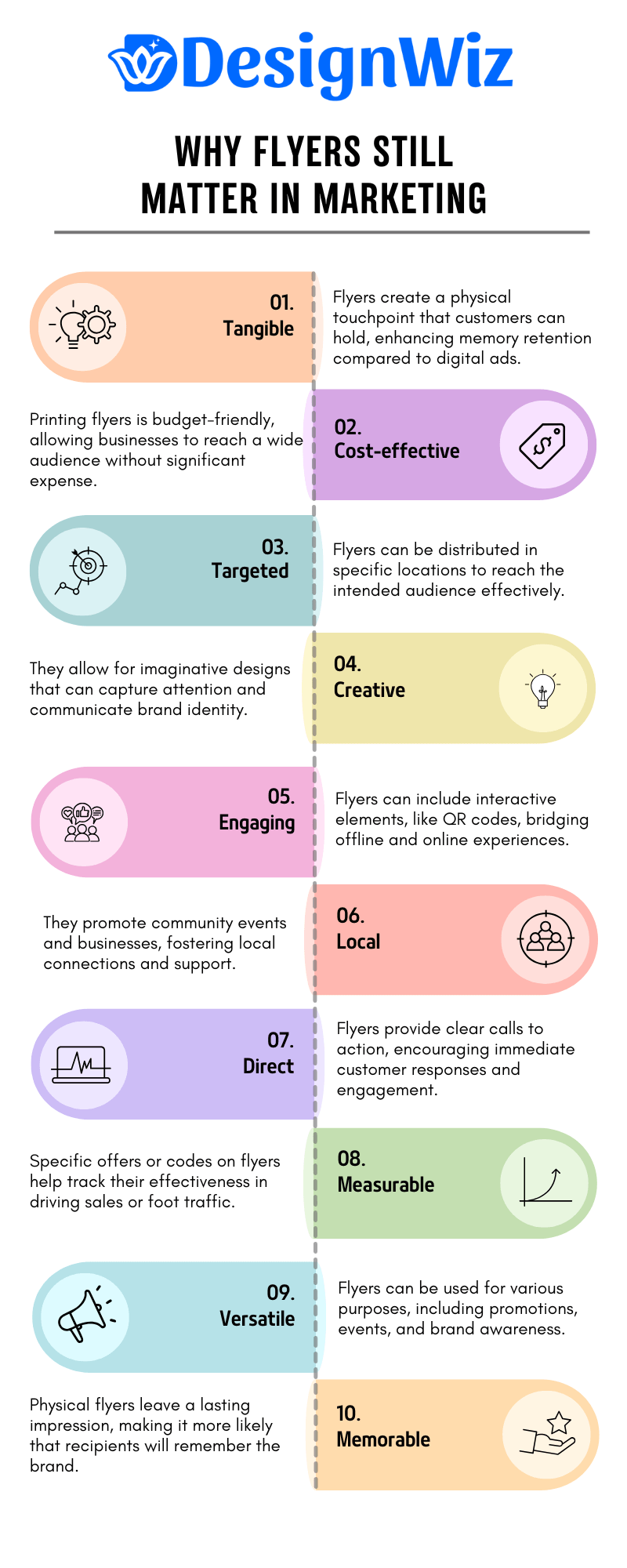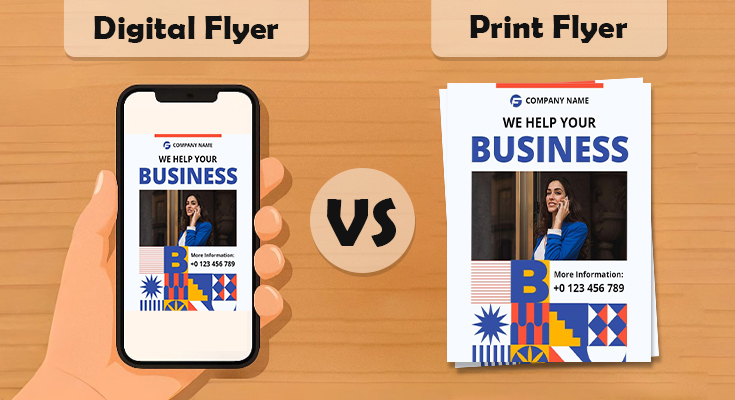In the evolving marketing world, businesses must go digital or stick with traditional print materials. Flyers, a staple in advertising, exemplify this divide. Both digital and print flyers have unique strengths and weaknesses, making them suitable for different audiences and purposes.
This blog delves into a comprehensive comparison of digital and print flyers. It highlights their pros, cons, and best-use scenarios to help you choose the right option for your marketing campaigns.
Why Flyers Still Matter in Marketing
Despite the rise of social media and digital advertising, flyers remain an effective way to grab attention and convey messages. Whether distributed online or physically handed out, flyers combine concise content with visually appealing designs to leave a lasting impression.

However, the decision between digital and print flyers can significantly impact your campaign’s success. Let’s dive deeper into their distinct features.
Comparison: Digital Flyers vs. Print Flyers
Here’s a detailed comparison of the two formats to help you decide:
| Aspect | Digital Flyers | Print Flyers |
|---|---|---|
| Cost | Minimal (no printing or delivery costs) | High (printing, paper, and distribution costs) |
| Reach | Global via email, websites, or social media | Local or event-specific reach |
| Customization | Easily editable and scalable | Static; reprinting needed for updates |
| Tactile Experience | None | Tangible and memorable |
| Environmental Impact | Eco-friendly with no waste | Contributes to paper and ink waste |
| Ease of Sharing | Instant via links, emails, or QR codes | Requires physical distribution |
| Longevity | Often ignored or deleted quickly | Can be retained and reused |
| Design Flexibility | Allows animations, videos, and links | Limited to static visuals |
| Interactivity | Clickable links, forms, or QR codes | None |
| Audience Accessibility | Requires internet and devices | Accessible to everyone, no technology needed |
| Production Time | Instant can be created and shared in hours | Time-intensive due to printing and delivery |
| Engagement Metrics | Trackable through analytics (click rates) | Difficult to measure the direct impact |
Pros of Digital Flyers
Cost-Effective
Creating digital flyers is affordable, especially for small businesses. There’s no need for printing or physical distribution, saving on materials and logistics.
For example, an email campaign using digital flyers can reach thousands of people at a fraction of the cost of printing and distributing physical flyers.
Instant Distribution
Digital flyers can be shared instantly via email, social media, or messaging platforms. They’re perfect for time-sensitive campaigns where speed is crucial.
Imagine announcing a flash sale – a digital flyer ensures your audience gets the message immediately.
Interactive Features
Digital flyers can include clickable links, animations, or embedded videos, enhancing engagement. This interactivity isn’t possible with print flyers.
A real estate agent could use a digital flyer to showcase a property with a virtual tour link, offering a dynamic experience for potential buyers.
Environmentally Friendly
With no paper or ink involved, digital flyers have a lower environmental footprint, appealing to eco-conscious audiences.
Cons of Digital Flyers
Dependence on Technology
Digital flyers require devices for viewing. If your audience isn’t tech-savvy or lacks internet access, your message might not reach them.
For instance, a local senior citizen group may struggle to engage with digital flyers compared to print ones.
Short Attention Span
In the digital space, attention spans are limited. Your flyer could be overlooked amidst the flood of online content.
An email flyer for a new café might end up in the spam folder or be ignored in a busy inbox.
Limited Emotional Connection
The tactile element of print is missing, which can reduce emotional impact. A digital flyer might not evoke the same sense of importance as a beautifully designed printed piece.
Pros of Print Flyers
Tangible and Memorable
The physical nature of print flyers creates a lasting impression. Holding something tangible often feels more personal and engaging.
A printed flyer for a boutique sale can serve as a keepsake or reminder, prompting customers to visit later.
High Visibility
Placed in strategic locations, print flyers are hard to miss. Unlike digital flyers, they don’t rely on users actively checking their devices.
A flyer on a community bulletin board or inside a coffee shop can reach a highly targeted local audience.
No Tech Barriers
Print flyers are accessible to everyone, regardless of their technological skills or internet access.
For example, a nonprofit organization distributing flyers at a community event ensures their message reaches all attendees, not just those online.
Better for Hyper-Local Marketing
Print flyers are ideal for promoting local businesses or events. You can directly reach people in the area who are most likely to attend or purchase.
Cons of Print Flyers
Higher Costs
Printing flyers can be expensive, especially for large campaigns. The cost per flyer increases significantly when factoring in design, paper quality, and delivery.
A small business owner might struggle to justify the expense of printing 1,000 high-quality flyers compared to a digital alternative.
Environmental Impact
Printed materials contribute to paper waste, making them less sustainable than digital options. This can be a disadvantage if your target audience values eco-friendly practices.
Static Content
Once printed, flyers can’t be updated. Any errors or outdated information require a costly reprint.
Best Uses for Digital Flyers
Digital flyers shine in scenarios where speed, reach, and interactivity are crucial. They are ideal for:
- Online Campaigns: Promoting sales, events, or services via email, social media, or websites.
- Global Reach: Targeting audiences beyond local boundaries.
- Eco-Friendly Brands: Businesses that prioritize sustainability.
- Email campaigns: Great for sending targeted offers or event invitations.
- Quick Updates: Campaigns requiring frequent changes or personalization.
Example: A software company promoting its latest product update with a digital flyer sent to its global email list.
Best Uses for Print Flyers
Print flyers are particularly effective for localized, personal interactions. They work best in:
- Local Events: Promoting events like fairs, concerts, or store openings.
- Direct Distribution: Handing flyers to customers in high-traffic areas.
- Tactile Campaigns: Creating an emotional connection with luxury designs and premium paper.
- Brick-and-mortar promotions: Placing flyers at the point of sale to attract foot traffic.
- Offline Audiences: Reaching people with limited internet access.
Example: A fitness studio handing out flyers in nearby neighborhoods to promote a new class schedule.
How to Decide Between Digital and Print Flyers
Choosing the right type of flyer depends on several factors:
Define Your Audience
- Are they tech-savvy or more traditional?
- Where are they located – locally or globally?
Evaluate Your Goals
- Need quick reach and updates? Go digital.
- Want a personal touch or local focus? Print flyers are better.
Assess Your Budget
- Tight budget? Opt for digital flyers.
- Have room for premium quality? Print flyers can impress.
Consider the Environment
- If sustainability is a priority, digital flyers align better with eco-friendly practices.
Real-World Success Stories
Understanding the potential of digital and print flyers is best illustrated through real-world examples. These success stories highlight how businesses effectively leveraged each type to achieve their goals.
Digital Flyers
A small local bakery utilized digital flyers on Instagram to promote a new product line. By designing visually appealing flyers and sharing them through Instagram Stories and posts, they reached thousands of local followers. A boosted ad campaign targeted specific demographics, increasing their visibility. Within a week, they experienced a 35% increase in sales and gained hundreds of new followers who engaged with their content.
Print Flyers
A family-owned restaurant launched a print flyer campaign in their neighborhood to announce a special weekend discount. The flyers, distributed to nearby homes and placed at local stores, included a coupon for a free appetizer with every meal. This strategy resulted in a 20% boost in weekend foot traffic and several new regular customers. The tangible nature of the flyers helped build a stronger connection with their local audience.
Industry-Specific Recommendations
Different industries benefit uniquely from digital and print flyers. Understanding how these formats cater to specific sectors helps businesses make informed choices for their marketing strategies.
Hospitality
Hotels and restaurants can benefit significantly from both types of flyers. Digital flyers can be used to promote seasonal offers, discounts, or special events through social media or email campaigns. Meanwhile, print flyers are perfect for in-room promotions, event invitations, or local restaurant menus distributed in nearby neighborhoods.
Event Planning
For event planners, digital flyers are ideal for creating buzz online, driving ticket sales, and sharing event details through social media and email. Print flyers, on the other hand, work well for tangible tickets, invitations, or programs distributed at the venue to create a polished, professional feel. Event planner flyer tips can help in designing effective flyers that capture attention and convey key information seamlessly.
E-Commerce
In the e-commerce space, digital flyers dominate due to their ability to include links to product pages, discount codes, and quick checkout options. These flyers can be easily shared across platforms, helping online businesses boost sales and reach a global audience.
Local Businesses
Local businesses such as retail stores or community services still find great value in print flyers for targeting nearby residents. Distributing flyers through direct mail or at local events ensures a strong, personal connection with the audience.
Future Trends in Flyers
The evolution of flyer marketing continues with emerging technologies and strategies. These trends show how businesses can stay ahead in a competitive landscape by innovating their flyer designs and campaigns.
Rise of AI in Flyer Design
Artificial intelligence is transforming flyer design for both digital and print formats. AI-powered tools can generate professional-quality designs in minutes. With the right artificial intelligence flyer ideas, businesses can create eye-catching and effective flyers effortlessly. These innovations make designing more efficient while maintaining a professional touch.
Personalization
AI and data analytics allow businesses to tailor flyer content to individual preferences. Digital flyers can include personalized recommendations, offers, or messages based on user behavior and demographics, making campaigns more effective and engaging.
Hybrid Campaigns
Innovative hybrid campaigns are bridging the gap between digital and print flyers. QR codes, NFC tags, and augmented reality (AR) elements are being integrated into print flyers, enabling audiences to interact with digital content seamlessly. For example, scanning a flyer can lead to an immersive AR experience or a direct link to an online store.
Conclusion:
Both digital and print flyers have their unique strengths. While digital flyers excel in cost-effectiveness, reach, and interactivity, print flyers stand out for their tangible impact and local focus.
The key lies in understanding your audience and campaign goals. In many cases, a hybrid approach works best – use digital flyers for broad reach and print flyers for local engagement.



